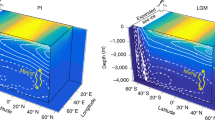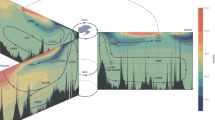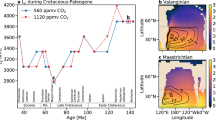Abstract
Earth’s climate and the concentrations of the atmospheric greenhouse gases carbon dioxide (CO2) and nitrous oxide (N2O) varied strongly on millennial timescales during past glacial periods. Large and rapid warming events in Greenland and the North Atlantic were followed by more gradual cooling, and are highly correlated with fluctuations of N2O as recorded in ice cores. Antarctic temperature variations, on the other hand, were smaller and more gradual, showed warming during the Greenland cold phase and cooling while the North Atlantic was warm, and were highly correlated with fluctuations in CO2. Abrupt changes in the Atlantic meridional overturning circulation (AMOC) have often been invoked to explain the physical characteristics of these Dansgaard–Oeschger climate oscillations1,2,3, but the mechanisms for the greenhouse-gas variations and their linkage to the AMOC have remained unclear4,5,6,7,8. Here we present simulations with a coupled model of glacial climate and biogeochemical cycles, forced only with changes in the AMOC. The model simultaneously reproduces characteristic features of the Dansgaard–Oeschger temperature, as well as CO2 and N2O fluctuations. Despite significant changes in the land carbon inventory, CO2 variations on millennial timescales are dominated by slow changes in the deep ocean inventory of biologically sequestered carbon and are correlated with Antarctic temperature and Southern Ocean stratification. In contrast, N2O co-varies more rapidly with Greenland temperatures owing to fast adjustments of the thermocline oxygen budget. These results suggest that ocean circulation changes were the primary mechanism that drove glacial CO2 and N2O fluctuations on millennial timescales.
This is a preview of subscription content, access via your institution
Access options
Subscribe to this journal
Receive 51 print issues and online access
$199.00 per year
only $3.90 per issue
Buy this article
- Purchase on Springer Link
- Instant access to full article PDF
Prices may be subject to local taxes which are calculated during checkout



Similar content being viewed by others
References
Broecker, W. S., Peteet, D. R. & Rind, D. Does the ocean-atmosphere system have more than one stable model of operation? Nature 315, 21–26 (1985)
Rahmstorf, S. Ocean circulation and climate during the past 120,000 years. Nature 419, 207–214 (2002)
Stocker, T. F. Past and future reorganizations in the climate system. Quat. Sci. Rev. 19, 301–319 (2000)
Menviel, L., Timmermann, A., Mouchet, A. & Timm, O. Meridional reorganizations of marine and terrestrial productivity during Heinrich events. Paleoceanography 23 PA1203 10.1029/2007PA001445 (2008)
Kohler, P., Joos, F., Gerber, S. & Knutti, R. Simulated changes in vegetation distribution, land carbon storage, and atmospheric CO2 in response to a collapse of the North Atlantic thermohaline circulation. Clim. Dyn. 25, 689–708 (2005)
Marchal, O., Stocker, T. F. & Joos, F. Impact of oceanic reorganizations on the ocean carbon cycle and atmospheric carbon dioxide content. Paleoceanography 13, 225–244 (1998)
Scholze, M., Knorr, W. & Heimann, M. Modelling terrestrial vegetation dynamics and carbon cycling for an abrupt climatic change event. Holocene 13, 327–333 (2003)
Goldstein, B., Joos, F. & Stocker, T. F. A modeling study of oceanic nitrous oxide during the Younger Dryas cold period. Geophys. Res. Lett. 30 1092 10.1029/2002gl01418 (2003)
Schmittner, A., Oschlies, A., Matthews, H. D. & Galbraith, E. D. Future changes in climate, ocean circulation, ecosystems and biogeochemical cycling simulated for a business-as-usual CO2 emission scenario until year 4000 AD. Glob. Biogeochem. Cycles 22 GB1013 10.1029/2007GB002953 (2008)
Meissner, K. J., Weaver, A. J., Matthews, H. D. & Cox, P. M. The role of land surface dynamics in glacial inception: a study with the UVic Earth System Model. Clim. Dyn. 21, 515–537 (2003)
Schmittner, A., Saenko, O. A. & Weaver, A. J. Coupling of the hemispheres in observations and simulations of glacial climate change. Quat. Sci. Rev. 22, 659–671 (2003)
Crowley, T. J. North Atlantic deep water cools the southern hemisphere. Paleoceanography 7, 489–497 (1992)
Schmittner, A. Decline of the marine ecosystem caused by a reduction in the Atlantic overturning circulation. Nature 434, 628–633 (2005)
Schmittner, A. et al. Large fluctuations of dissolved oxygen in the Indian and Pacific oceans during Dansgaard-Oeschger oscillations caused by variations of North Atlantic Deep Water subduction. Paleoceanography 22 PA3207 10.1029/2006PA001384 (2007)
Fluckiger, J. et al. N2O and CH4 variations during the last glacial epoch: Insight into global processes. Glob. Biogeochem. Cycles 18 GB1020 10.1029/2003GB002122 (2004)
Nevison, C., Butler, J. H. & Elkins, J. W. Global distribution of N2O and the ΔN2O-AOU yield in the subsurface ocean. Glob. Biogeochem. Cycles 17, 1119 (2003)
Blunier, T. & Brook, E. J. Timing of millennial-scale climate change in Antarctica and Greenland during the last glacial period. Science 291, 109–112 (2001)
Sowers, T., Alley, R. B. & Jubenville, J. Ice core records of atmospheric N2O covering the last 106,000 years. Science 301, 945–948 (2003)
Schmittner, A., Brook, E. J. & Ahn, J. in Ocean Circulation: Mechanisms and Impacts — Past and Future Changes of Meridional Overturning (eds Schmittner, A., Chiang, J. C. H. & Hemming, S. R.) 209–246 (Vol. 173, Geophysical Monograph Series, American Geophysical Union, 2007)
Sigman, D. M. & Haug, G. H. in Treatise On Geochemistry Vol. 6 (eds Holland, H. D. & Turekian, K. K.) 491–528 (Elsevier Science, 2003)
Toggweiler, J. R. et al. Representation of the carbon cycle in box models and GCMs — 2. Organic pump. Glob. Biogeochem. Cycles 17 1026 10.1029/2001GB001401 (2003)
Ito, T. & Follows, M. J. Preformed phosphate, soft tissue pump and atmospheric CO2 . J. Mar. Res. 63, 813–839 (2005)
Ahn, J. & Brook, E. J. Atmospheric CO2 and climate on millennial time scales during the last glacial period. Science 322, 83–85 (2008)
Ahn, J. & Brook, E. J. Atmospheric CO2 and climate from 65 to 30 ka BP. Geophys. Res. Lett. 34 L10703 10.1029/2007GL029551 (2007)
Schmittner, A., Latif, M. & Schneider, B. Model projections of the North Atlantic thermohaline circulation for the 21st century assessed by observations. Geophys. Res. Lett. 32 L23710 10.1029/2005GL024368 (2005)
Le Quere, C. et al. Saturation of the Southern Ocean CO2 sink due to recent climate change. Science 316, 1735–1738 (2007)
Peltier, W. R. Global glacial isostasy and the surface of the ice-age earth: The ICE-5G (VM2) model and GRACE. Annu. Rev. Earth Planet. Sci. 32, 111–149 (2004)
Andersen, K. K. et al. High-resolution record of Northern Hemisphere climate extending into the last interglacial period. Nature 431, 147–151 (2004)
EPICA. One-to-one coupling of glacial climate variability in Greenland and Antarctica. Nature 444, 195–198 (2006)
Indermuhle, A. et al. Atmospheric CO2 concentration from 60 to 20 kyr BP from the Taylor Dome ice core, Antarctica. Geophys. Res. Lett. 27, 735–738 (2000)
Acknowledgements
This study was funded by the NSF Marine Geology and Geophysics programme grant 0728315-OCE, and the NSF Paleoclimate programme grant 0602395-ATM. We thank J. Ahn, E. Brook, R. Toggweiler and V. Brovkin for discussions and comments on the manuscript.
Author Contributions A.S. designed the study and performed the numerical experiments. E.D.G. performed the comparison with the proxy record. A.S. and E.D.G. discussed the results and contributed equally to the analysis of the data and writing of the paper.
Author information
Authors and Affiliations
Corresponding author
Supplementary information
Supplementary Information
This file contains Supplementary Notes, Supplementary Figures S1-S3 with Legends and Supplementary References (PDF 805 kb)
Rights and permissions
About this article
Cite this article
Schmittner, A., Galbraith, E. Glacial greenhouse-gas fluctuations controlled by ocean circulation changes. Nature 456, 373–376 (2008). https://doi.org/10.1038/nature07531
Received:
Accepted:
Issue Date:
DOI: https://doi.org/10.1038/nature07531
This article is cited by
-
Millennial scale feedbacks determine the shape and rapidity of glacial termination
Nature Communications (2021)
-
Direct astronomical influence on abrupt climate variability
Nature Geoscience (2021)
-
A salty deep ocean as a prerequisite for glacial termination
Nature Geoscience (2021)
-
Glacial heterogeneity in Southern Ocean carbon storage abated by fast South Indian deglacial carbon release
Nature Communications (2020)
-
Southern Ocean convection amplified past Antarctic warming and atmospheric CO2 rise during Heinrich Stadial 4
Communications Earth & Environment (2020)
Comments
By submitting a comment you agree to abide by our Terms and Community Guidelines. If you find something abusive or that does not comply with our terms or guidelines please flag it as inappropriate.



